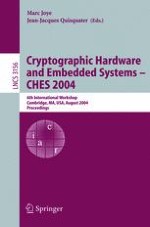2004 | Buch
Cryptographic Hardware and Embedded Systems - CHES 2004
6th International Workshop Cambridge, MA, USA, August 11-13, 2004. Proceedings
herausgegeben von: Marc Joye, Jean-Jacques Quisquater
Verlag: Springer Berlin Heidelberg
Buchreihe : Lecture Notes in Computer Science
Enthalten in: Professional Book Archive
